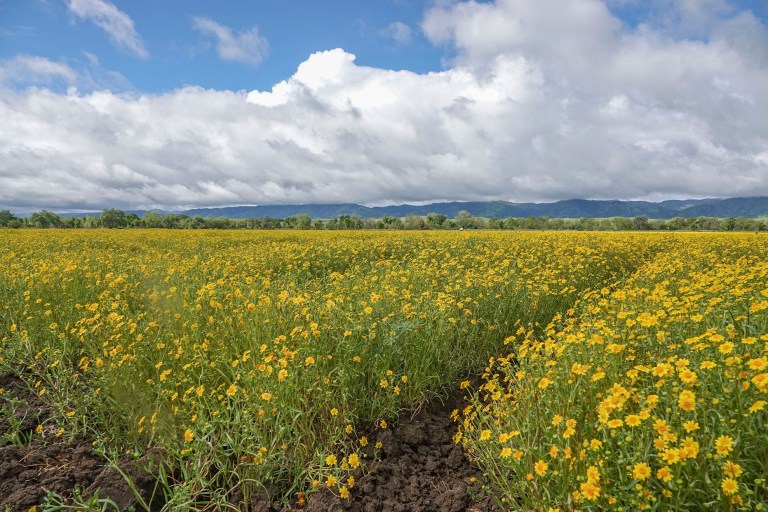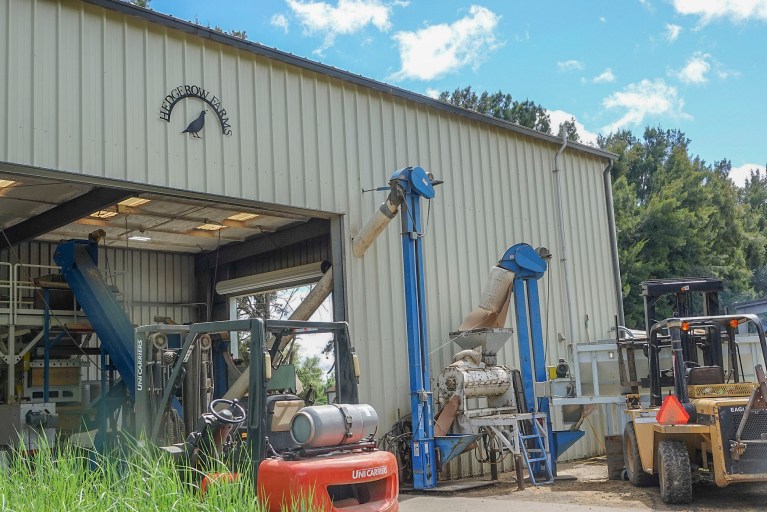I am weary of begging readers to send in wildlife photos, as I have about three days left. If nobody sends any in, we’ll go to sporadic presentations and then. . . . nothing. Then the Caturday felids will go and then. . . the void.
But today we have a presentation by UC Davis ecologist Susan Harrison, who visited a wildflower farm. Here captions and IDs are indented, and you can enlarge the photos by clicking on them. There are two bird pictures at the end.
Visit to a Wildflower Farm
To restore degraded land and improve it for wildlife, there have to be farms that provide native plant seeds in large amounts. Native seed farming is a highly skilled enterprise in which source material is often gathered from the wild, cultivation must be done with care to maintain adaptive genetic traits, and all techniques from germinating through harvesting and storage must be tailored for numerous finicky plant species. It’s a tough business to succeed in, and there’s a great need for more of it.
Hedgerow Farms in Winters, California is a much-admired member of Northern California’s native seed industry. Their chief scientist, a recent graduate of our Ecology program at UC Davis, invited me to attend their annual Field Day in April 2024. It was a fun and enlightening experience.
Touring the fields on a hay bale ride:
Goldfields, Lasthenia californica:
Desert Poppies, Eschscholzia californica mexicana (orange field):
Cream Cups, Platystemon californica, with a smattering of Succulent Lupine, Lupinus succulentus, that was grown in the same field last year:
Blue-eyed Grass, Sisyrinchium bellum, not a grass but a member of the iris family:
The wildflowers (or “forbs”) are beautiful, but grasses are grown and used in much larger quantities.
Meadow Barley (Hordeum brachyantherum):
Purple Needlegrass, Stipa pulchra, the most popular species in Californian grassland restoration, intermixed with leftover California Phacelia, Phacelia californica:
Sedges, Carex species, essential for restoring streambanks:
Growing native seeds requires a great deal of both manual labor and creatively MacGyvered farm machinery.
Hoeing a field of Woolly Sunflower (Eriophyllum lanatum):
Seed cleaning apparatus, in which field-harvested material enters from the bins on the right of this photo, passes through a series of threshing and sifting machines adjusted differently for each plant species, and emerges as bags of nearly-pure seed:
Seed samples on display:
Native plants are also used for the conservation practices with which enlightened farmers retain their soils and support wildlife. Tailwater ponds and hedgerows are two such practices that we saw on the tour.
Tailwater ponds are small wetlands that trap irrigation runoff and allow sediments to be recycled onto the fields:
Hedgerows are roadside plantings that provide food and cover for wildlife, and may stabilize canals and ditches:
A hedgerow of native shrubs (yellow: Flannelbush, Fremontodendron californcum; pink: Western Redbud, Cercis occidentalis; blue: California-lilac, Ceanothus); note the more typical, barren roadside in the foreground:
Okay, now for the animals! Among this farm’s many community partners is the falconry club, who brought their beautiful birds to the field day. From left to right are a Peregrine Falcon (Falco peregrinus), female Harris’s Hawk (Parabuteo unicinctus), two Merlins (Falco columbarius), and male Harris’s Hawk:
Several birds and people in this photo are falconry-based pest abatement professionals. The most famous pest-abating bird is Rufus the Hawk, a Harris’s Hawk who keeps pigeons off the courts at Wimbledon.
Harris’s Hawk closeup:
From Allaboutbirds on Harris’s Hawk: “The most social of North American raptors, these birds cooperate at nests and hunt together as a team. When hunting, a group of hawks surround their prey, flush it for another to catch, or take turns chasing it. This hawk’s social nature and relative ease with humans has made it popular among falconers and in education programs.”

















Can’t resist:
If there’s a bustle in your hedgerow, don’t be alarmed now
It’s just a spring clean for the May queen
Fantastic pictures! And does anybody else see the irony in Susan’s narrative?
“Native seed farming is a highly skilled enterprise in which source material is often gathered from the wild, cultivation must be done with care to maintain adaptive genetic traits, and all techniques from germinating through harvesting and storage must be tailored for numerous finicky plant species.”
Before we ruined our giant native plant reservoir, native plants flourished all by themselves. Now it takes a massive effort to bring them back.
Like the oxymoron “wildlife management”. Let’s just hope such restoration projects can someday catch up with, or better yet, outpace the destruction.
Thanks Susan. Pretty cool.
Thanks for this highly informative post about wildflower farms. I’m especially amazed by the seed cleaning apparatus, with threshing and sifting machines that must be adjusted for seed size.
A very labour-intensive operation, and one that requires a great deal of knowledge about a wide range of plant species.
It’s good to see that businesses such as this can thrive, although it’s a shame that their services are required.
What an amazing set! This was extra special, and thank you for sharing!
I do have a set of pictures to share, but i have been to busy with work to make the final push.
Very peaceful and calming. Nice to know native plants and grasses with special “jobs.”